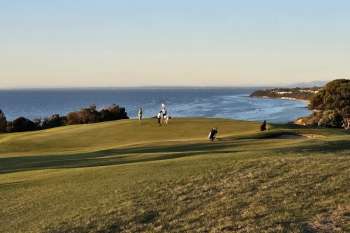Question Time with Robert Trent Jones II - Feature Interview Part II
Darius Oliver - How would you describe a typical Robert Trent Jones Junior golf course? Is there an over-riding philosophy evident on all the courses you have designed?
Robert Trent Jones II - If there are principals that I and the people who are in my school have, and remember I am the Oak Tree and they are the acorns, is that I try for strategic design, meaning choices, options, a way to think differently on different days or where you are in the match or where the wind is or the other elements that are not apparent such as how you feel, how you swing etc.
Let me put it this way. If somebody of your knowledge comes up to me and I say, ‘how do you like my new course?’ and you say, ‘nice course’, I would think I failed. Nice course is a polite complement meaning OK, or not that exciting. If you came up to me and said, ‘god I hated the 7thhole and yet the 13th hole the downhill par four was so interesting’ then I would say that I have succeeded because you love and hate which means that as a creator I have challenged your mind, and your golf game and I have, like a poet, reached your golfing heart. OK. That’s a compliment.
So the answer to your question, if I can make you think of every shot, choose different shots, including the tee shot which has now become thoughtless by many of the skillful players, that is the best compliment I could get as a principal. I want you to think on every shot. The second thing is, as an architect this idea somehow that minimalism is the fashion of the moment – they seem like unfinished golf courses to me. It’s great to go with the land, so I let the land speak to me, not me to the land. I do not bring a preconceived golf design concept to the land, each piece of land is different, each piece of marble was different for Michelangelo, each piece of canvas is different. You have to compose your art according to the canvas you’ve been given.
So that’s two things. I’m site specific, I work with teams of people who understand it and I ask people who are indigenous and local. Like here in Australia, Bruce Grant was very helpful on the bunkering at The National. We borrowed a lot from Royal Melbourne. As T.S. Elliot said, good poets borrow, great poets steal. We stole from Royal Melbourne. The bunkering here is Royal Melbourne-ish, Sandbelt bunkering with the severe lips, big deep bunkers and so forth. So in this location those bunkers are appropriate. To do that in flat Florida would seem outrageously Donald Trump style, it would be over the top. So that’s what site specific means.
DO - In terms of your design principals and the desire for options rather than penal golf, does a course like this one (The National) straddle the boundary of what is or isn’t fair and reasonable?
RTJ - The old 16th hole (current 3rd) has always been uncomfortable to me, since the day I walked it. Great tee shot but the severity of the uphill shot and the flag disappears on the top deck, so we’re going to slightly revise it again so the ball doesn’t roll back down.
But what I like about this course is the greens themselves are very very edgy. You are right on the edge of what is puttable. They (the members) love it, which makes me happy. If you ask the pros they would probably not love it. They want to be able to make 20 footers like 2 footers and you can’t here. Second thing is you don’t always play to the flagstick here, so the edginess of the greens is the defense. If you want to defend the nature of par then defend with the greens not by longer and longer golf courses. I think this is where we first did it, here at the National. We have done it since at Chambers Bay. You play away from the flagstick on the 12th hole there, it’s a drivable par four but I can tell you players often come off there with fours and fives.
DO - Do you ever return to your older courses and identify areas that you would like to change?
RTJ - Yes, often.
DO - What about here at The National?
RTJ - I mentioned one hole that always troubled me. I’d like to make sure they re-establish the bunkers. It’s cut out of the tea-tree and the Moonah trees, which gives it a very private feel. You are in your own game in your own hole, you don’t see anybody else. It has obvious dramatic scenery, but it also has an enclosed feel to get out of the wind so we laid it out in the hollows so you were not in the wind when you took a backswing and got blown away, or putting the ball would oscillate on the greens. At the same time we made the features very strong because the land was very strong.
DO - What about places like Joondalup, Meadow Springs, Coolum etc?
RTJ - Well I’d have to go back to Joondalup, but I wouldn’t change much at Joondalup on the original two nines, the third nine is a little weak compared to the others. By weaker I mean it’s more traditional. Meadow Springs is just a beautiful walk in the golf park, it’s very simple in the land. And we did it for very little money. Coolum has evolved. We just changed six holes two years ago, we lost some of the seaside holes some of which were very good, as a trade off.
Those courses were built during what I call my Aussie period. I was working in Australia, New Zealand, South Pacific, Hawaii, big lands that the TV world hadn’t caught up with yet. There were no iPhones, and we were building bigger courses because we were given the land and that was what I would call my very strong, manly period of architecture in the 1980s and early 90s.
Back to NewsMore News
Report reveals golf's $3.3 billion contribution to Australia
AGIC report reveals total annual benefits to the Australian community, economy and environment from golf.
Cape Wickham Links – The Inside Design Story
Co-designer Darius Oliver reveals the truth behind the design of Australia’s premier modern golf course
Min Woo Lee signs up for Aussie PGA title defence
Reigning champion locks in the defence of his title at Royal Queensland Golf Club in November
Have your say on the future of Moore Park Golf
Golfers unite – another one of our cherished public access golf courses is under threat




